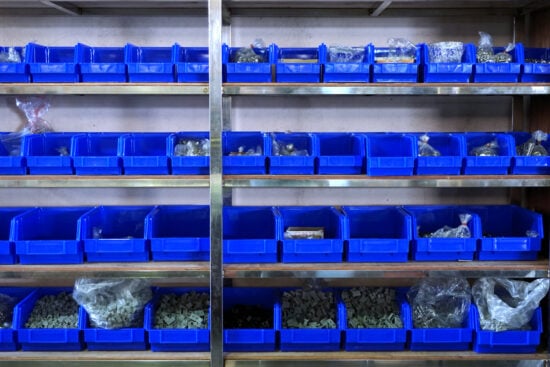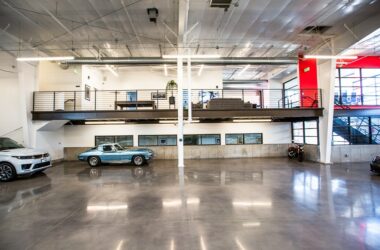There are numerous methods for storing goods in a warehouse, from block stacking to storage systems. However, proper inventory management is critical to remain relevant in the highly competitive and fast-paced market. In this case, placing products on racks is the best method in a warehouse that handles multiple products. In this guide, we look at different warehouse storage systems and what they offer.
What Are Warehouse Storage Systems?
A storage system includes physical structures designed to stack products optimally in horizontal rows and multiple levels. These solutions streamline warehouse operations by efficiently using available space, proper organization, and ease of access.
There are two significant categories of racking; compact and direct access warehouse storage systems.
Direct access racking system offers complete access to materials, simplifying order picking and storage processes. Examples include pallet racks, mobile racking systems, and cantilever racks.
On the other hand, compact racks provide more storage space and accommodate numerous materials. Examples include drive-in/drive-thru pallet racks and push-back racks.
Choosing between the two racking systems depends on various factors such as consumption criteria, SKUs (Stock Keeping Units), and the warehouse’s needs.
What to Consider Before Selecting Between Warehouse Storage Systems
Every warehouse has unique requirements. However, a good storage system should improve space utilization without affecting warehouse operations, especially order picking tasks. Some of the factors to consider include:
- Cost: The price of every pallet is a significant factor. Warehouse managers should work within their budget when choosing an efficient racking system.
- Storage space utilization: Consider the amount of storage space the ranking system offers. The area needed depends on weight, size, and quantity of stock.
- Floor space utilization: The storage systems should maximize the warehouse’s floor space.
- Versatility: Storage system potential to store a wide range of materials
- Forklift maneuver: A perfect racking system should offer enough aisle width for forklift accessibility, especially if the warehouse stores bulky cargo.
- Inventory management: The method of products retrieval used by the warehouse
Warehouse Storage Systems
1. Selective pallet racking systems
A selective pallet storage system allows direct access to a stored pallet without moving the others. It features a streamlined goods retrieval process.
This system is perfect for warehouses that hold different products, require access to all stored goods simultaneously, and have a high volume of cargo movements. Its primary advantage is accommodating any unit load, volume, and weight.
A selective racking solution is for FIFO (First-In, First-Out) inventory management that involves loading and unloading pallets from the front. LIFO (Last-In, First-Out) inventory management also works for the double deep selective racking system.
However, a selective rack system requires numerous aisles. Therefore, it’s a low-density solution compared to other storage solutions.
The budget for this warehouse storage system ranges between 45 to 65 dollars per pallet. Its storage utilization is 90% -95%, while the floor utilization is 40%. Forklifts can also maneuver effortlessly, all thanks to the wider aisles.
2. Pallet flow storage systems
The pallet flow system is a high-density storage solution that utilizes dynamic components and elevated rails. The racks support inclined wheels or rollers. As a result, it is easier for the pallets to move from the loading to the picking aisle. Back pallets automatically glide into the loading position once the front pallet moves.
A pallet flow rack system can double the utilization volume of any warehouse. So it’s a perfect choice for date-sensitive goods like beverage and food storage.
The pallet flow system’s cost per pallet ranges from$170 to $185. It features 70 to 75% floor utilization and 85 to 90% storage utilization.
3. Mobile shelving
High-density mobile shelving involves storing more goods in less space. Traditional static shelves occupy a fixed amount of storage space. Unfortunately, the frames aren’t flexible enough to accommodate the changes when inventory increases. Overcrowding and disorganization may lead to safety hazards for warehouse employees, reduced morale, and lower productivity.
Fortunately, mobile shelving storage solution solves all these problems by mounting cabinets or shelves onto a rail and carriage system. The system also eliminates permanent aisles to accommodate numerous pallets in a limited space.
Mobile shelving solution increases storage capacity. The warehouse can house the same amount of products in half the space.
While the system is suitable for storage units running at any temperature, it’s ideal in cold storage facilities and freezer warehouses.
The mobile shelving system can improve the operations in this 16’x7′ basement storage unit in Lehi, UT.
4. Drive-in and drive-through pallet racks
Drive-in/drive-through racks are excellent for homogeneous products with numerous pallets per SKU. The storage system features lanes inside the shelves. Forklifts move through these lanes, carrying goods elevated above the product’s storage space height.
Drive-through and drive-in warehouse storage systems are convenient for storing goods with an extended life span and materials that require one-time moves. Warehouse operators can also use these systems alongside other racking systems like pallet tracks.
However, logistic providers and manufacturers of raw materials and consumer goods use drive-through and drive-in solutions as a single system. They also come in handy in cold storage warehouses.
Drive-through rack systems allow a lift truck to maneuver through two ends of the system when unloading and loading for FIFO inventory management.
However, the drive-in systems move through the front and back out after loading and unloading for a LIFO inventory management option. This system provides high density but with lower selectivity than the drive-through system.
The budget for a drive-in storage system ranges between 160 to 185 dollars. Its floor utilization is 65%, while the storage utilization is 60-65%.
Drive-in/drive-through storage systems aren’t very versatile; they don’t store different goods in a row.
These systems are ideal for this warehouse in Lindon, UT.
5. Push-back storage systems
Push-back systems maximize storage space and minimize the required aisle. It’s a high-density storage solution that utilizes the warehouse cube. The carts supported by the racks pass through inclined rails.
Push-back systems are perfect for warehouses that need access to different SKUs simultaneously and freezer environments.
These systems are for LIFO inventory management. They use front loading/unloading; the back pallet pushes the first pallet onto a cart. The back pallet then glides to the front for unloading.
- Features a budget of $275 to $295 per pallet
- 75% floor utilization
- 75% storage utilization
- Ideal for accommodating same SKU products
- Supports forklifts
6. Wire partitions
Wire partitions systems are wire cages strategically placed in warehouses to hold products. They feature easy and quick installation and removal.
These storage systems often support awkwardly shaped and bulky products like balls and tires. They are, however, not the best solution for fragile items.
Wire partitioners also hold goods that require additional security or items that aren’t safe when stored on shelves.
This system can improve storage in the 12’x20′ garage space in Bermuda Dunes, CA.
7. Cantilever racks
Cantilever storage systems hold long products like pipes, lumber, molding, plastic sheets, and metal profiles.
The system features two columns that support load-bearing arms. The arms are fixed temporarily, so it’s easy to change their position based on the length of the product.
The primary advantage of cantilever racks is that they are versatile enough to accommodate different goods, regardless of size. They are mainly used in warehouses that store extra-long products such as automotive goods, home décor, and machinery.
Benefits of Automated and Retrieval Systems (AS/RS)
Automating a warehouse increases agility, safety, and productivity. It also reduces operational costs. For example:
Stacker cranes
Stacker cranes automate pallet racks, pallet shuttle systems, and pallet flow racks by inserting and then extracting them from their locations.
Unlike standard forklifts, stacker cranes can function within a narrow aisle. This means the warehouse can then hold more products. They also allow continuous cargo exits and entries.
Voice picking systems
Voice picking systems simplify the pick and pack operation. They are better than picking via RF transmitters or paper. The operator also doesn’t look down to check the next step.
They enable a single-touch, hands-free process and offer numerous benefits, including:
- Boosting pick accuracy
- Reducing dependence on packing operators
- Integrating the picking and fulfillment procedures and, in turn, improving efficiency
- Increasing pick volume
Final Thoughts on Warehouse Storage Systems
The ideal storage system meets the needs of a specific warehouse cost-effectively. For instance, wide-span shelving and carton flow racks are an excellent pick for warehouses that store small boxes and products.
In a nutshell, storage companies should choose a storage system based on storage space, versatility, cost, and type of inventory management. If you need a storage solution that fits your business, then browse Neighbor for local options.








